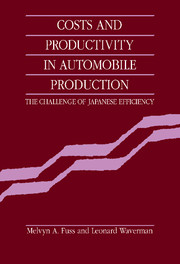Book contents
- Frontmatter
- Contents
- Preface
- Chapter 1 Introduction
- Chapter 2 International differences in output, productivity, and wages in the automobile industry: the 1950s to the mid-1980s
- Chapter 3 The cost-function approach to the analysis of cost and total factor productivity differences
- Chapter 4 Data base sources and method of construction
- Chapter 5 Empirical results: estimation of the cost function
- Chapter 6 Productivity growth in the automobile industry, 1970–1984: a comparison of the United States, Japan, Germany, and Canada
- Chapter 7 International comparisons of automobile industry cost and productivity levels: Japan, Germany, and the United States
- Chapter 8 International comparisons of automobile industry cost and productivity levels: Canadian with U.S., Japanese, and German production
- Chapter 9 Summary and conclusions
- References
- Index
Chapter 4 - Data base sources and method of construction
Published online by Cambridge University Press: 16 October 2009
- Frontmatter
- Contents
- Preface
- Chapter 1 Introduction
- Chapter 2 International differences in output, productivity, and wages in the automobile industry: the 1950s to the mid-1980s
- Chapter 3 The cost-function approach to the analysis of cost and total factor productivity differences
- Chapter 4 Data base sources and method of construction
- Chapter 5 Empirical results: estimation of the cost function
- Chapter 6 Productivity growth in the automobile industry, 1970–1984: a comparison of the United States, Japan, Germany, and Canada
- Chapter 7 International comparisons of automobile industry cost and productivity levels: Japan, Germany, and the United States
- Chapter 8 International comparisons of automobile industry cost and productivity levels: Canadian with U.S., Japanese, and German production
- Chapter 9 Summary and conclusions
- References
- Index
Summary
The basic sources of much of the data used are the various censuses of manufacturers in each of the countries studied. From these sources we acquired data on output, labor and materials inputs, and investment. For Germany, we relied on a data bank compiled by Klaus Conrad at the University of Mannheim. Data on capital services, the prices of output and inputs, capacity utilization, and technical change were acquired from other sources detailed in Appendix 4.C. A number of problems were encountered, including the benchmarking of the cost of production across countries as well as accounting for the very different types of motor vehicles produced.
Coverage of the data
Although the coverage of the 3-digit motor vehicles data is reasonably similar across the four countries, there are some discrepancies. In Canada, unlike Japan, automotive products foundries, aluminum casting plants, auto glass plants, and motorcycle production are not included in automotive sector data. In the United States, unlike Japan, automotive stamping, vehicular lighting equipment, engine electrical equipment, and motorcycle production are not included. For Germany, the only major difference (relative to Japan) is that repair work is included in the definition of the automotive industry. It is not possible to determine accurately the quantitative impact of these discrepancies, but we estimate they amount to 5–10% of the value of gross output for Canada and for the United States. Any bias imparted by omission of the listed subindustries should be reasonably small.
- Type
- Chapter
- Information
- Costs and Productivity in Automobile ProductionThe Challenge of Japanese Efficiency, pp. 80 - 115Publisher: Cambridge University PressPrint publication year: 1992



